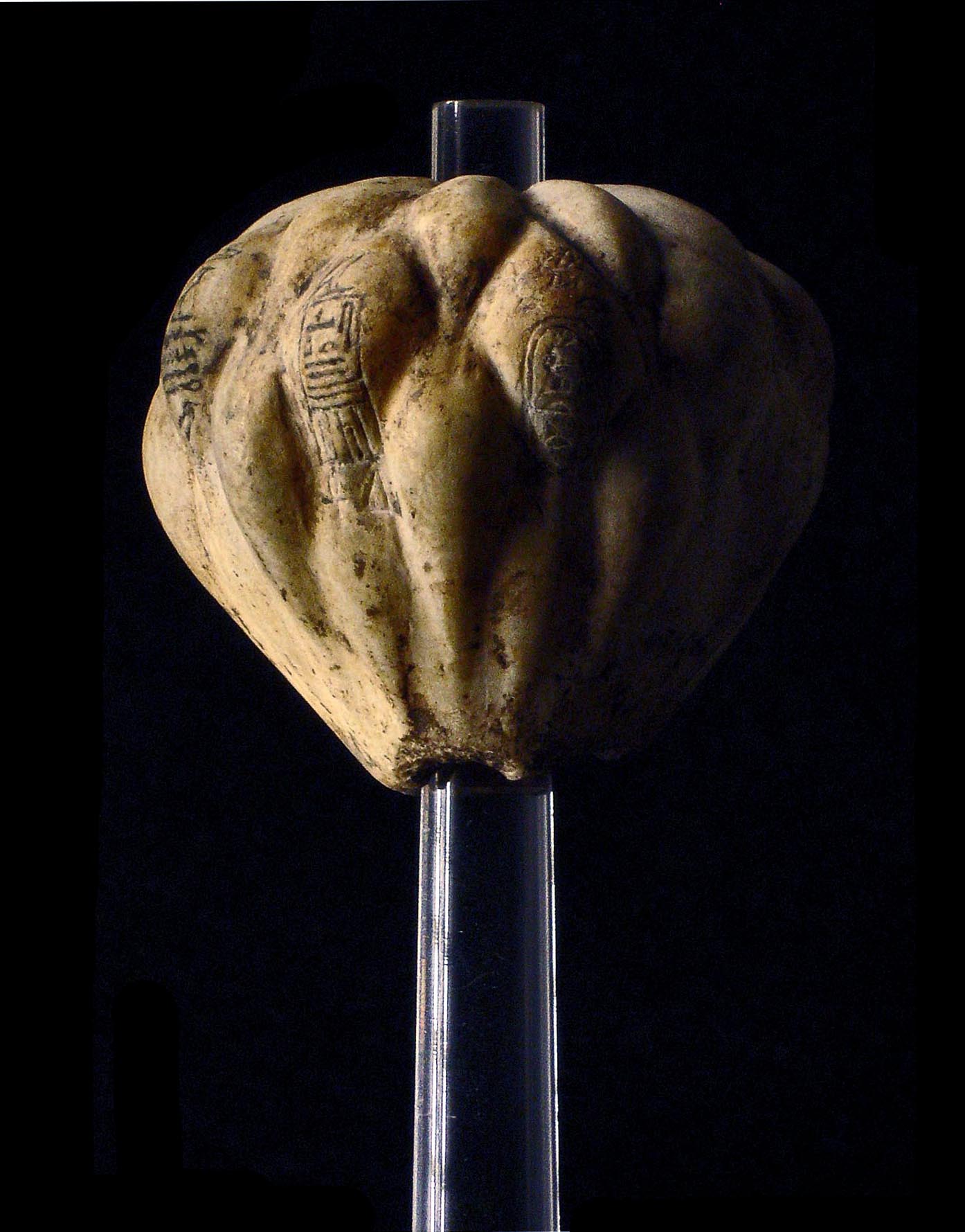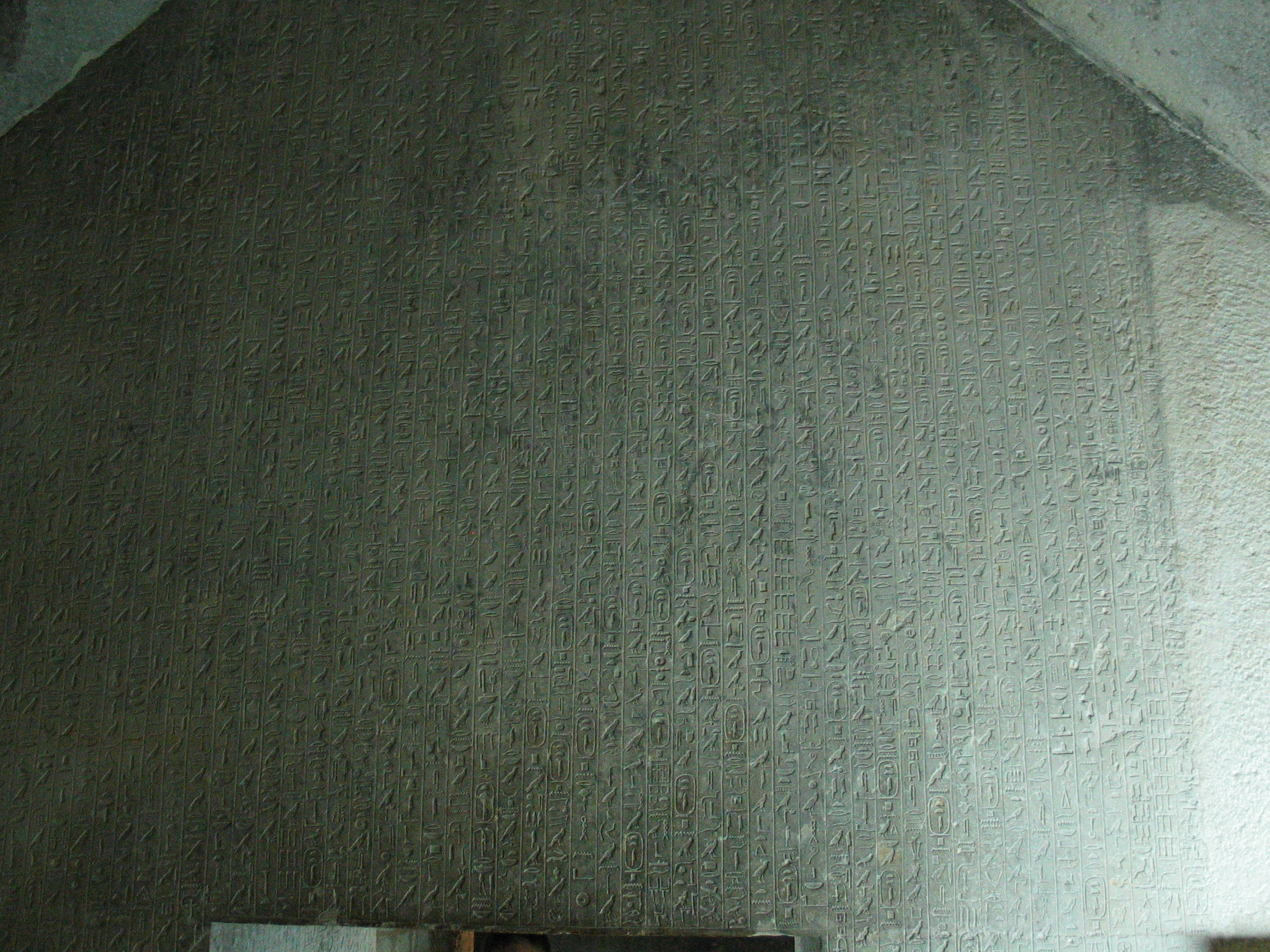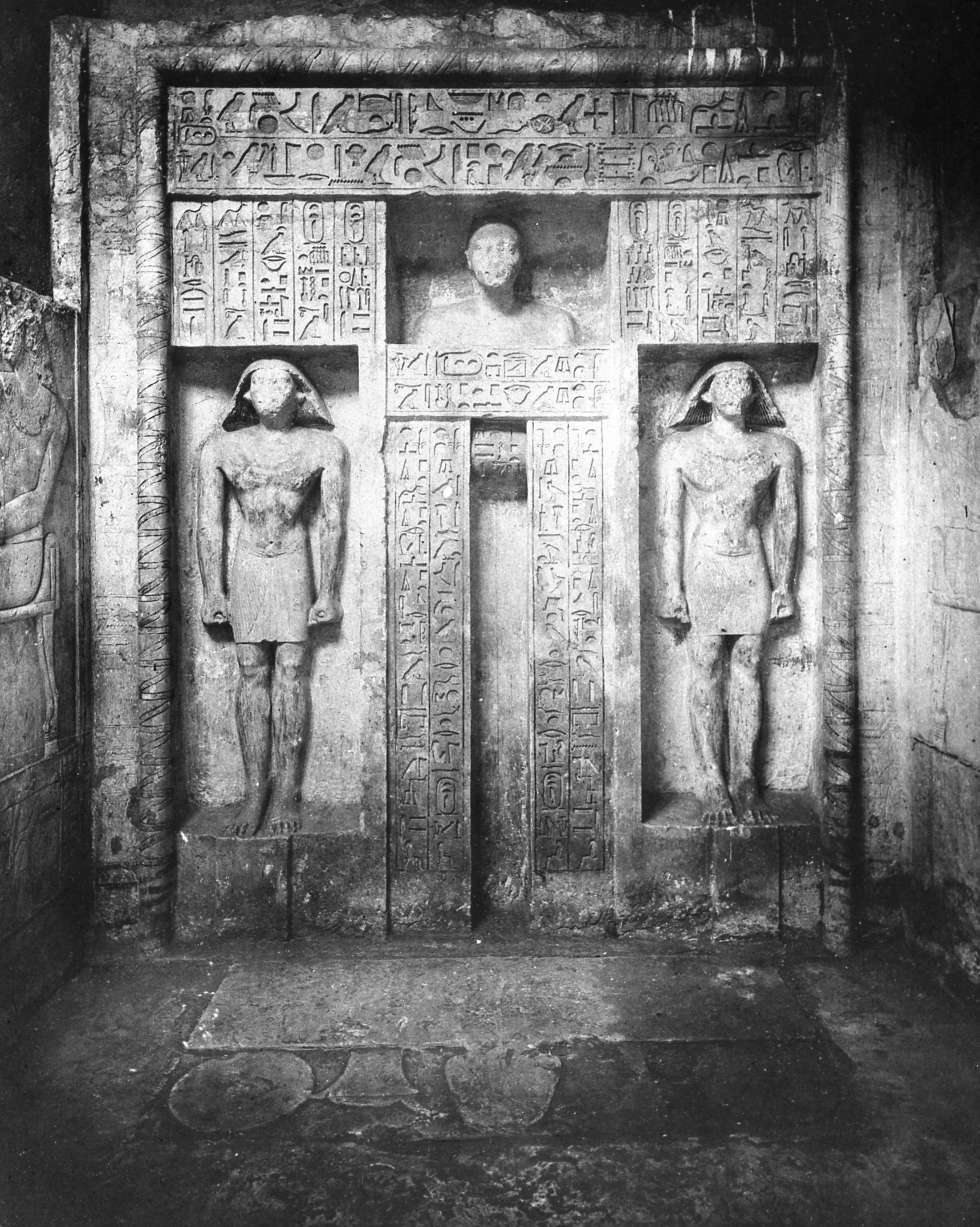|
Pyramid Of Teti
The pyramid of Teti is a smooth-sided pyramid situated in the pyramid field at Saqqara in Egypt. It is the second known pyramid containing pyramid texts. Excavations have revealed a satellite pyramid, two pyramids of queens accompanied by cult structures, and a funerary temple. The pyramid was opened by Gaston Maspero in 1882 and the complex explored during several campaigns ranging from 1907 to 1965. It was originally called ''Teti's Places Are Enduring''. The preservation above ground is very poor, and it now resembles a small hill. Below ground the chambers and corridors are very well preserved. The funerary complex The pyramid complex of Teti follows a model established during the reign of Djedkare Isesi, the arrangement of which is inherited from the funerary complexes of Abusir. A valley temple, now lost, was probably destroyed in antiquity due to the place of an Old Kingdom temple dedicated to Anubis constructed there. A better known funerary temple, revealed by Jame ... [...More Info...] [...Related Items...] OR: [Wikipedia] [Google] [Baidu] |
Teti
Teti, less commonly known as Othoes, sometimes also Tata, Atat, or Athath in outdated sources, was the first king of the Sixth Dynasty of Egypt. He was buried at Saqqara. The exact length of his reign has been destroyed on the Turin King List but is believed to have been about 12 years. Biography Teti had several wives: *Iput, the daughter of Unas, the last king of the Fifth dynasty. Iput was the mother of Pepi I. *Khuit, who may have been the mother of Userkare (according to Jonosi and Callender)Miroslav Verner, The Pyramids,1994 *Khentkaus IV *Neith Teti is known to have had several children. He was the father of at least three sons and probably ten daughters. Of the sons, two are well attested, a third one is likely: * Pepi I * Tetiankhkem * Nebkauhor, with the name of Idu, "king’s eldest son of his body", buried in the mastaba of Vizier Akhethetep/Hemi, buried in a fallen Vizier’s tomb, within the funerary complex of his maternal grandfather According to N. Kanawati, T ... [...More Info...] [...Related Items...] OR: [Wikipedia] [Google] [Baidu] |
Peribolos
In ancient Greek and Roman architecture, a peribolos was a court enclosed by a wall, especially one surrounding a sacred area such as a temple, shrine, or altar. This area, however, is not a necessary element to these structures since those built earlier only included markers (e.g. ''horoi'' or boundary stones) to indicate imaginary boundaries. Excavations reveal that there are sanctuaries that included a peribolos later in its history, signifying a change in religious mentality. During the Roman times, there were pereboloi used as meeting places to conduct business (e.g. shipping). Peribolos walls (which may also be referred to as temenos walls) were sometimes composed of stone posts and slabs supported by porous sills. Famous examples included: * the peribolos wall and gate in the Sanctuary of Zeus (Altis), north of the Temple of Zeus at Olympia, Greece; * the peribolos enclosing the Altar of the Twelve Gods near the north end of the Athens ancient Agora; and * the terrace cr ... [...More Info...] [...Related Items...] OR: [Wikipedia] [Google] [Baidu] |
Cartouche
In Egyptian hieroglyphs, a cartouche is an oval with a line at one end tangent to it, indicating that the text enclosed is a royal name. The first examples of the cartouche are associated with pharaohs at the end of the Third Dynasty, but the feature did not come into common use until the beginning of the Fourth Dynasty under Pharaoh Sneferu. While the cartouche is usually vertical with a horizontal line, if it makes the name fit better it can be horizontal, with a vertical line at the end (in the direction of reading). The ancient Egyptian word for cartouche was , and the cartouche was essentially an expanded shen ring. Demotic script reduced the cartouche to a pair of brackets and a vertical line. Of the five royal titularies it was the ''prenomen'' (the throne name), and the "Son of Ra" titulary (the so-called '' nomen'' name given at birth), which were enclosed by a cartouche. At times amulets took the form of a cartouche displaying the name of a king and placed in tombs. ... [...More Info...] [...Related Items...] OR: [Wikipedia] [Google] [Baidu] |
Death Mask
A death mask is a likeness (typically in wax or plaster cast) of a person's face after their death, usually made by taking a cast or impression from the corpse. Death masks may be mementos of the dead, or be used for creation of portraits. It is sometimes possible to identify portraits that have been painted from death masks because of the characteristic slight distortions of the features caused by the weight of the plaster during the making of the mould. The main purpose of the death mask from the Middle Ages until the 19th century was to serve as a model for sculptors in creating statues and busts of the deceased person. Not until the 1800s did such masks become valued for themselves. In other cultures a death mask may be a funeral mask, an image placed on the face of the deceased before burial rites, and normally buried with them. The best known of these are the masks used in ancient Egypt as part of the mummification process, such as Tutankhamun's mask, and those from M ... [...More Info...] [...Related Items...] OR: [Wikipedia] [Google] [Baidu] |
Viscera
In biology, an organ is a collection of tissues joined in a structural unit to serve a common function. In the hierarchy of life, an organ lies between tissue and an organ system. Tissues are formed from same type cells to act together in a function. Tissues of different types combine to form an organ which has a specific function. The intestinal wall for example is formed by epithelial tissue and smooth muscle tissue. Two or more organs working together in the execution of a specific body function form an organ system, also called a biological system or body system. An organ's tissues can be broadly categorized as parenchyma, the functional tissue, and stroma, the structural tissue with supportive, connective, or ancillary functions. For example, the gland's tissue that makes the hormones is the parenchyma, whereas the stroma includes the nerves that innervate the parenchyma, the blood vessels that oxygenate and nourish it and carry away its metabolic wastes, and the co ... [...More Info...] [...Related Items...] OR: [Wikipedia] [Google] [Baidu] |
Greywacke
Greywacke or graywacke (German ''grauwacke'', signifying a grey, earthy rock) is a variety of sandstone generally characterized by its hardness, dark color, and poorly sorted angular grains of quartz, feldspar, and small rock fragments or lithic fragments set in a compact, clay-fine matrix. It is a texturally immature sedimentary rock generally found in Paleozoic strata. The larger grains can be sand- to gravel-sized, and matrix materials generally constitute more than 15% of the rock by volume. The term "greywacke" can be confusing, since it can refer to either the immature (rock fragment) aspect of the rock or its fine-grained (clay) component. The origin of greywacke was unknown until turbidity currents and turbidites were understood, since, according to the normal laws of sedimentation, gravel, sand and mud should not be laid down together. Geologists now attribute its formation to submarine avalanches or strong turbidity currents. These actions churn sediment and cause mi ... [...More Info...] [...Related Items...] OR: [Wikipedia] [Google] [Baidu] |
Pyramid Texts
The Pyramid Texts are the oldest ancient Egyptian funerary texts, dating to the late Old Kingdom. They are the earliest known corpus of ancient Egyptian religious texts. Written in Old Egyptian, the pyramid texts were carved onto the subterranean walls and sarcophagi of pyramids at Saqqara from the end of the Fifth Dynasty, and throughout the Sixth Dynasty of the Old Kingdom, and into the Eighth Dynasty of the First Intermediate Period. The oldest of the texts have been dated to c. 2400–2300 BCE. Unlike the later Coffin Texts and Book of the Dead, the Pyramid Texts were reserved only for the pharaoh and were not illustrated. The use and occurrence of Pyramid Texts changed between the Old, Middle, and New Kingdoms of Ancient Egypt. During the Old Kingdom (2686 BCE – 2181 BCE), Pyramid Texts could be found in the pyramids of kings as well as three queens, named Wedjebten, Neith, and Iput. During the Middle Kingdom (2055 BCE – 1650 BCE), Pyramid Texts were not written in t ... [...More Info...] [...Related Items...] OR: [Wikipedia] [Google] [Baidu] |
Serdab
A serdab ( fa, سرداب, d=Sardāb), literally meaning "cold water", which became a loanword in Arabic for 'cellar' is an ancient Egyptian tomb structure that served as a chamber for the Ka statue of a deceased individual. Used during the Old Kingdom, the serdab was a sealed chamber with a small slit or hole to allow the soul of the deceased to move about freely. These holes also let in the smells of the offerings presented to the statue. The term ''serdab'' is also used for a type of undecorated chamber found in many pyramids. Due to the lack of inscriptions, it has been impossible to determine the ritual function of this chamber, but many Egyptologists view it as a storage space, akin with the underground storehouses in private and royal tombs of the Second Dynasty.Ägypten Die Welt der Pharaonen, 1998. Pages 68 It is easiest recognized by its position in the east end of the pyramid's internal chamber system and the three niches in its outer wall. The earliest serdab of this ty ... [...More Info...] [...Related Items...] OR: [Wikipedia] [Google] [Baidu] |
Harrow (tool)
In agriculture, a harrow is a farm implement used for surface tillage. It is used after ploughing for breaking up and smoothing out the surface of the soil. The purpose of harrowing is to break up clods and to provide a soil structure, called tilth, that is suitable for planting seeds. Coarser harrowing may also be used to remove weeds and to cover seed after sowing. Harrows differ from ploughs, which cut the upper 12 to 25 centimetre (5 to 10 in) layer of soil, and leave furrows, parallel trenches. Harrows differ from cultivators in that they disturb the whole surface of the soil, while a cultivator instead disturbs only narrow tracks between the crop rows to kill weeds. There are four general types of harrows: disc harrows, tine harrows (including spring-tooth harrows, drag harrows, and spike harrows), chain harrows, and chain-disk harrows. Harrows were originally drawn by draft animals, such as horses, mules, or oxen, or in some times and places by manual labourers. I ... [...More Info...] [...Related Items...] OR: [Wikipedia] [Google] [Baidu] |
Teti Pyramid
Teti, less commonly known as Othoes, sometimes also Tata, Atat, or Athath in outdated sources, was the first king of the Sixth Dynasty of Egypt. He was buried at Saqqara. The exact length of his reign has been destroyed on the Turin King List but is believed to have been about 12 years. Biography Teti had several wives: *Iput, the daughter of Unas, the last king of the Fifth dynasty. Iput was the mother of Pepi I. *Khuit, who may have been the mother of Userkare (according to Jonosi and Callender)Miroslav Verner, The Pyramids,1994 *Khentkaus IV *Neith Teti is known to have had several children. He was the father of at least three sons and probably ten daughters. Of the sons, two are well attested, a third one is likely: * Pepi I * Tetiankhkem * Nebkauhor, with the name of Idu, "king’s eldest son of his body", buried in the mastaba of Vizier Akhethetep/Hemi, buried in a fallen Vizier’s tomb, within the funerary complex of his maternal grandfather According to N. Kanawati, T ... [...More Info...] [...Related Items...] OR: [Wikipedia] [Google] [Baidu] |
Pyramid Of Djedkare Isesi
The pyramid of Djedkare Isesi (in ancient Egyptian ''Nfr Ḏd-kꜣ-rꜥ'' ("Beautiful is Djedkare")) is a late 25th to mid 24th century BC pyramid complex built for the Fifth Dynasty pharaoh Djedkare Isesi. The pyramid is referred to as ''Haram el-Shawaf'' ( ar, هَرَم ٱلشَّوَّاف, Haram ash-Shawwāf, lit=The Sentinel Pyramid) by locals. It was the first pyramid to be built in South Saqqara. Djedkare Isesi's monument complex encompasses: a main pyramid; a mortuary temple situated on the east face of the main pyramid; a valley temple buried under modern Saqqara; a causeway that has been only partially dug out; and a cult pyramid. The main pyramid had a six-stepped core built from roughly cut limestone bound together by clay mortar which was then encased in fine white Tura limestone reaching a peak height of . The casing has been plundered, and the top three steps of the core have been lost, leaving the pyramid a paltry tall. The basic dimensions of Djedkare's pyr ... [...More Info...] [...Related Items...] OR: [Wikipedia] [Google] [Baidu] |
Saqqarah Teti 01
Saqqara ( ar, سقارة, ), also spelled Sakkara or Saccara in English , is an Egyptian village in Giza Governorate, that contains ancient burial grounds of Egyptian royalty, serving as the necropolis for the ancient Egyptian capital, Memphis. Saqqara contains numerous pyramids, including the Step pyramid of Djoser, sometimes referred to as the Step Tomb, and a number of mastaba tombs. Located some south of modern-day Cairo, Saqqara covers an area of around . Saqqara contains the oldest complete stone building complex known in history, the Pyramid of Djoser, built during the Third Dynasty. Another sixteen Egyptian kings built pyramids at Saqqara, which are now in various states of preservation. High officials added private funeral monuments to this necropolis during the entire Pharaonic period. It remained an important complex for non-royal burials and cult ceremonies for more than 3,000 years, well into Ptolemaic and Roman times. North of the area known as Saqqara lie ... [...More Info...] [...Related Items...] OR: [Wikipedia] [Google] [Baidu] |








